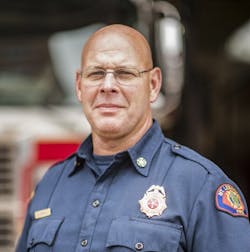NFPA Standards: NFPA 1720: An Update on the Volunteer Deployment Standard
The first edition of NFPA 1720: Standard for the Organization and Deployment of Fire Suppression Operations, Emergency Medical Operations, and Special Operations to the Public by Volunteer Fire Departments was released in 2001. It was the first organized approach to defining deployment capabilities for “substantially” volunteer fire departments and provided the volunteer fire service with a tool to provide a true picture of the risks in the community and the fire department’s capabilities to respond to and manage those risks to local politicians and residents. The NFPA 1720 committee includes representation from the Delaware Volunteer Firefighters Association, the Fire Department Safety Officers Association, the International Association of Fire Chiefs, the Kentucky Fire Commission, the National Association of Towns and Townships, the National Volunteer Fire Council, Volunteer Fireman’s Insurance Services and members from several volunteer fire departments that are located throughout the country.
The early drafts of this standard were met with significant opposition, particularly from rural departments that believed that a volunteer fire service deployment standard would put them out of business. However, the organizations that participated on the committee understood the uniqueness of the volunteer fire service, the different services that are provided and how volunteer departments differ in the way that they deploy resources and respond to incidents compared with other departments. Thus, the standard wasn’t meant to be one-size-fits-all but both a benchmark and an outline for volunteer departments. They could use the standard to begin to measure and evaluate their own capabilities, provide the community with a picture of what those capabilities are and allow the authority having jurisdiction (AHJ) to ultimately decide the level of service that’s provided.
The table is based on a low-hazard occupancy, such as a 200-square-foot, two-story, single-family house that lacks a basement and exposures. Additional resources would be required for fires in other occupancies and for other risks that are in the community that present greater hazards, including:
- High-hazard occupancies, including schools, hospitals, nursing homes, explosives plants, refineries, high-rise buildings and other high-life-hazard or large-fire-potential occupancies
- Medium-hazard occupancies, including apartments, offices, and mercantile and industrial occupancies that normally don’t require extensive rescue or firefighting forces
- Low-hazard occupancies, including one-, two- and three-family dwellings and scattered small businesses and industrial occupancies
Although NFPA 1710 response-time goals were intended to increase the likelihood of the arrival of the first-due unit prior to flashover, the response-time goals in NFPA 1720 are intended to reflect the reality of the volunteer response system. We know that a fire burns relatively the same regardless of whether the community is served by a career fire department or a volunteer fire department. To this end, it’s understood by the NFPA 1720 committee that the outcomes of an engine that’s staffed with four personnel that arrives in 6½ minutes and of the balance of the alarm of 16 firefighters (17 if an aerial device is used) that arrives in 10½ minutes from the time that the call is received at the dispatch center versus a volunteer department that assembles 10 firefighters within 10 minutes of the time of dispatch (call handling time not included) aren’t likely to be the same as each other.
The major changes
For the 2020 edition of NFPA 1720, the committee made several changes throughout the document, including the addition of fire prevention practices as well as fire investigations. (NFPA 1730: Standard on Organization and Deployment of Fire Prevention Inspection and Code Enforcement, Plan Review, Investigation, and Public Education Operations should be consulted for fire prevention, community education and fire investigation services.)
The committee also spent considerable time discussing the definition of “volunteer fire department.” Previous editions defined a volunteer fire department as having volunteer emergency service personnel who comprise at least 85 percent of its department membership. As a result of these committee discussions and of the realization that increasingly more volunteer fire departments provide incentives to volunteers and/or are supplemented by some type of paid staff, new annex material was added to clarify the definition.
A.3.3.16.2 Volunteer Fire Department. Volunteer fire department members can include paid part-time and on-call members. In those arrangements, volunteer firefighters only partially are compensated, and the costs that are associated with being a firefighter often aren’t covered fully by their stipend or pay. (Those costs include lost wages from their primary occupation for training and responding to dispatches.) Their pay might be hourly based and might or might not qualify for volunteer status under the Fair Labor Standards Act (FLSA). In addition, many paid part-time and on-call firefighters who serve at combination departments still volunteer or are unpaid for part or all of the time that they spend on training, administrative tasks, equipment maintenance, public education and fundraising, and they often cover the cost of supplemental training themselves.
4.4.3.3. Under the existing section 4.4.3, regarding quadrennial reporting, the fire department is required to annually evaluate its level of service, deployment delivery and response time objectives and to provide a written report that’s based on the annual evaluations to the AHJ quadrennially. A new plan development requirement helps the AHJ to address areas that aren’t being met or that could develop over the following three years.
The new section includes: The report shall identify any deficiencies that could develop in the next three years and address the steps that are necessary to continue to achieve compliance with this standard.
Departments that currently are unable to meet the standard and those that identify deficiencies that could develop should evaluate what steps, if any, that the department could take to improve compliance. These steps might include: adding additional automatic and/or mutual aid to alarm assignments; implementing volunteer duty shifts, whereby a number of volunteers staff the station as opposed to responding from home; establishing response protocols that allow certain members to meet the apparatus at the incident scene; implementing technologies that provide faster notification and information as to the number of responding personnel; and/or adding part-time or full-time staff. Although, ultimately, it’s up to the local governing body to determine what level of service that it’s willing to fund, it’s the responsibility of the fire department to ensure that the governing body is informed of the capabilities and deficiencies of the service that’s delivered based on the current level of support.
Finally, the committee added the new 5.5 Pre-Incident Planning requirement, which dictates that pre-incident plans be in accordance with NFPA 1620: Standard for Pre-Incident Planning.
5.5.1. The fire department shall set forth operational requirements to conduct pre-incident planning. (Fire departments, when conducting pre-fire planning, should use NFPA 1620 for fires and other related emergencies).
5.5.2. Particular attention shall be provided to target hazards.








